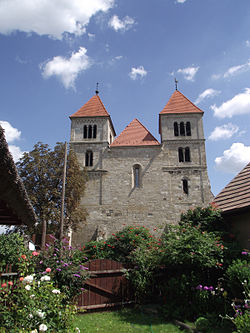Ócsa
Ócsa | |
|---|---|
 Ócsa | |
| Country | |
| County | Pest |
| Area | |
• Total | 81.64 km2 (31.52 sq mi) |
| Population (2007) | |
• Total | 8,953 |
| • Density | 108.68/km2 (281.5/sq mi) |
| Time zone | UTC+1 (CET) |
| • Summer (DST) | UTC+2 (CEST) |
| Postal code | 2364 |
| Area code | 29 |
Ócsa is a town in Pest county, Budapest metropolitan area, Hungary.
The Árpád Age Romanesque church


The church was originally built in the 13th century by the Premonstratensians for use as a monastery. During the 16th century the village was reformed and the structure was given to the village for use as a public place of worship.[citation needed]
One of the most beautiful Romanesque churches preserved in Hungary, it has 3 naves, a cross nave, and two western towers, following the style common to Hungarian medieval architecture. It was renewed in the 20th century, according to the plans of modern-day architect (hu:Foerk Ernő). The church is interesting not only for its architecture, but for the murals of Saint Ladislaus I of Hungary, the Legendary painted on the northern walls.
Numerous preserved houses and structures in the vicinity recall the life and times of the Hungarian medieval age, including tools, furniture, and other objects of interest.
Bird observatory
A long-standing bird observatory known as the Ócsai Madárvárta is located nearby.
Notable residents
- Tamás Csilus, footballer.
Twin towns — Sister cities
References
- Gerevich Tibor: Magyarország románkori emlékei, (Romanesque Heritage in Hungary.) Királyi Magyar Egyetemi Nyomda, Budapest, 1938.
- Gerő László (1984): Magyar műemléki ABC. Budapest,
- Henszlmann Imre: Magyarország ó-keresztyén, román és átmeneti stylü mű-emlékeinek rövid ismertetése, Királyi Magyar Egyetemi Nyomda, Budapest, 1876.
External links
- Official website
- Ócsa for tourists
- lap.hu links about Ócsáról
- Natural protection district near Ócsa
- Aerial images about Ócsa
- Street map Template:Hu icon



